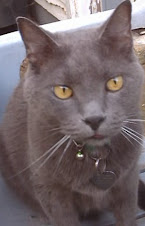The first event that started me thinking about this technique was when my friend Brigitte sent me some old (1967ish) National Geographic magazines. Next, I was fortunate enough to find some turpentine at our Houseshold Hazardous Waste "Swap and Shop." Since both of these were free, the only money I had invested in this experiment was the foam brush, which didn't last too long after it went in the turp. Of course, I had to wait until it was nice enough outside, because let me assure you, this is NOT an indoor project.
 Here are the supplies I used clockwise from upper left: punchinella (sequin waste, which is optional), turpentine, old container to hold the turp, National Geographic magazine pages (anywhere from a few pages to the entire magazine), brush (I used a large foam one), paper towels. Underneath it all, I placed a plastic bag and butcher paper, since I wasn't sure how much the turp would saturate the butcher paper, but I also wasn't sure if the turp would "melt" the plastic (which it did not).
Here are the supplies I used clockwise from upper left: punchinella (sequin waste, which is optional), turpentine, old container to hold the turp, National Geographic magazine pages (anywhere from a few pages to the entire magazine), brush (I used a large foam one), paper towels. Underneath it all, I placed a plastic bag and butcher paper, since I wasn't sure how much the turp would saturate the butcher paper, but I also wasn't sure if the turp would "melt" the plastic (which it did not). Place a small amount of turp in the container of your choice, then saturate your brush with the turp.
Place a small amount of turp in the container of your choice, then saturate your brush with the turp. Coat both sides of the pages liberally with the turpentine. It will soak through unevenly, so you will probably have to reapply the turp in some places.
Coat both sides of the pages liberally with the turpentine. It will soak through unevenly, so you will probably have to reapply the turp in some places. Here is an example of how the turpentine saturates unevenly. Keep applying turpentine until the entire page is saturated. you can see from both the magazine and the butcher paper below it, you will be able to tell where the turp is.
Here is an example of how the turpentine saturates unevenly. Keep applying turpentine until the entire page is saturated. you can see from both the magazine and the butcher paper below it, you will be able to tell where the turp is. When completely saturated, press together, twist, and manipulate the print so it merges or distorts. I used bright colors, then paired them with pages of text. You may also place punchinella between two of the pages while it is drying. Sally suggested blotting some of the pages, but when I did, it didn't do much except remove the turp. It didn't move the ink like I think it did with her experiment. However, that's why I had and used the paper towels.
When completely saturated, press together, twist, and manipulate the print so it merges or distorts. I used bright colors, then paired them with pages of text. You may also place punchinella between two of the pages while it is drying. Sally suggested blotting some of the pages, but when I did, it didn't do much except remove the turp. It didn't move the ink like I think it did with her experiment. However, that's why I had and used the paper towels.I allowed the pages to dry outside. I also twisted and pressed the pages together, to further manipulate the inks. The drying is crucial, because if you allow the pages to dry too long together, they will stick together. Although I read on Sally's blog that her turp smell disappeared, mine was still present days later. That's why I still haven't taken photos of the finished product. They still smell and gave me a terrible headache, even though I did this project outside. Anyone who knows me, knows I don't get sick over most art products, but this was one technique I will probably shy away from doing again, unless it's really windy outside.


















































































.JPG)

























1 thoughtful remarks:
this is a cool technique. I wondered if you've used CITRA-Solve; I have on old (before 1980) National Geographic magazines and I never get the result one can see on You Tube. Any pointers?
Post a Comment